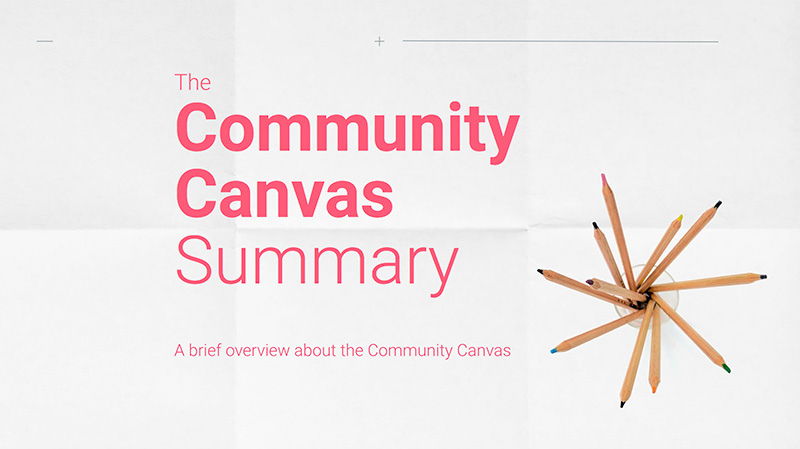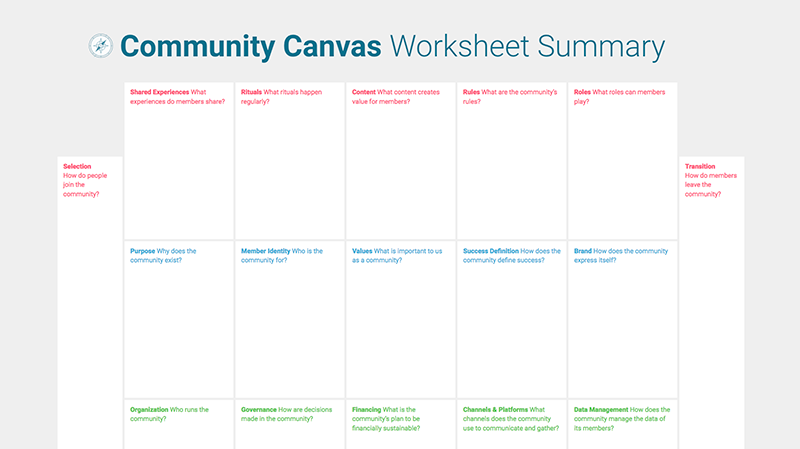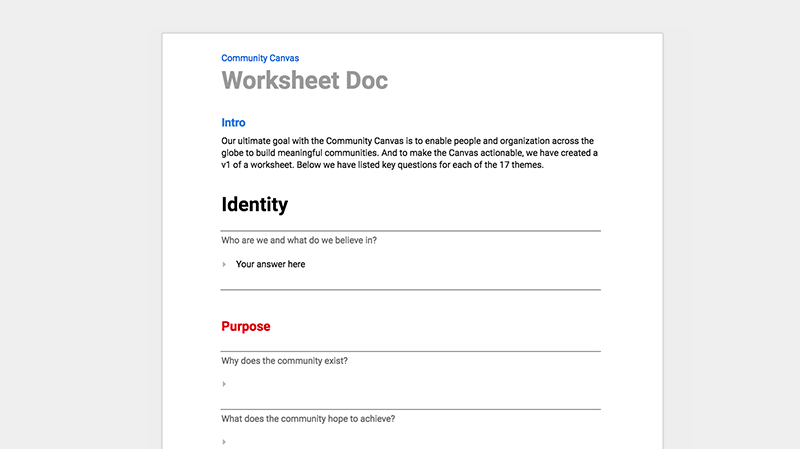By Fabian Pfortmüller, Nico Luchsinger, Sascha Mombartz
Introduction
The Community Canvas is a framework that helps people and organizations build stronger communities. It provides a template for anyone who brings people together.
This framework will help you build and run a new community, or analyze and improve an existing community. It identifies the fundamental themes to cover and helps you ask the right questions. “Community” means something different to every person. We have developed this tool in the hope of supporting anyone who runs an organization that brings people together and makes them feel like they belong.
Below is a brief introduction to the Community Canvas’s three sections and links to the summary, full guide and worksheets. It is also available in other languages.
3 Sections
The Community Canvas has 3 Sections Identity, Experience, Structure which in turn are divided into 17 Themes.
1. Identity
Who are we and what do we believe in?
The first part of the Canvas focuses on questions of belief. Strong communities have a clear and explicit sense of who they are, why they exist and what they stand for. These aspects of the community are less tangible than the points covered in later parts of the Canvas. And as a result, they often get passed over. However, we believe that a confident sense of identity builds the very core of a successful community and informs all other elements around it. That’s why in our Canvas, the Identity is the beating heart at the center of everything else, giving meaning and life to the rest of the organization.
The Identity section itself is layered like an onion. At its core are two elements: the community’s purpose and the identity of its members. The questions why and who are quintessential and then inform the other elements of identity: the organization’s values, its definition of success and its brand. An authentic culture is one of the most valuable elements of any community, but also a very abstract concept to act upon. The elements covered under Identity are key ingredients towards a thriving community culture.
Themes
- Purpose – Why does the community exist?
- Member Identity – Who is the community for?
- Values – What is important to us as a community?
- Success – Definition How does the community define success?
- Brand – How does the community express itself?
2. Experience
What happens in the community and now does it create value for members?
In the second part of the Canvas we explore the community from the perspective of the members: what does actually happen in the community and how does it translate its purpose into activities that create tangible value for the members? Every community experience starts with a member joining and at some point – consciously or not – a member leaving. Successful communities design these transition moments between the outside and the inside world as part of a larger journey. A significant part of the Canvas is dedicated to two elements:
- Shared Experiences bring members together and fundamentally deepen the bonds among them.
- Rituals and traditions are individual and recurring experiences that have a strong symbolic character.
The community’s content strategy contributes to the overall experience. Communities who tell the stories of their members and share relevant content strengthen the bond among members and increase the overall value. Every member is different and evolves over time. Smart communities provide different roles catering to different needs throughout the experience. Lastly, we have found communities to work best when they have clear rules set in advance, so people know what their rights and expected responsibilities are.
Themes
- Selection – How do people join the community?
- Transition – How do members leave the community?
- Shared Experiences – What experiences do members share?
- Rituals – What rituals happen regularly?
- Content – What content creates value for members?
- Rules – What are the community’s rules?
- Roles – What roles can members play?
3. Structure
What gives us stability in the long run?
The third part of the Canvas focuses on the operational elements of running a community. While many communities evolve organically over time, only few survive in the long-term. Organizational aspects are often neglected, and the necessary structures aren’t in place to deal with challenging situations, as they eventually and often suddenly come up. This area goes beyond good management and processes, but presents a tremendous opportunity: most communities become more valuable the longer they exist, as trust both among the members and into the overall brand increases. But consistency is key.
Visionary communities will put structures in place that will optimize for long-term stability.
Leadership deserves special attention in a community, as many are partially or fully volunteer run. What does that mean for incentive models, job descriptions and knowledge transfers? Decision making is best clarified in advance and helps avoid and address conflicts, a surprisingly common sight within many communities.
Many communities fail because they do not figure out how to become financially sustainable. We highlight different models. Most successful communities exist both in the offline and the online world and the choice of the right platforms matter. Lastly, the members’ data is among the communities most valuable assets and it deserves thoughtful management.
Themes
- Organization – Who runs the community?
- Governance – How are decisions made in the community?
- Financing – What is the community’s plan to be financially sustainable?
- Channels & Platforms – What channels does the community use to communicate and gather?
- Data Management – How does the community manage the data of its members?
Download Resources
Download Community Canvas Summary
The Canvas and it’s 3 Sections in a nutshell.

The 3 Sections and each of the 17 Themes covered in detail with key questions, further background and observations.

We created a Minimum Viable Community template, choosing the most crucial 9 questions to start with.
Download Worksheets
Answer the questions of the Canvas for your own community.
Worksheet Summary
The Visual Summary has all themes and one key question on one page. PDF.

Worksheet Doc
The comprehensive Google Doc lists each of the 17 themes with all questions, ideal for choosing what is relevant to your needs and creating your own community strategy.

Open Google Doc
Download PDF, 28 Pages
Licence
We hope that people will take the Community Canvas and make it their own. That’s why we’re releasing it as a Creative Commons license Attribution-NonCommercial-ShareAlike 4.0 International (CC BY-NC-SA 4.0) – which means you can build upon the material, copy and share it for any non-commercial purpose as long as you give credit to community-canvas.org.
Explore Further
- Community Mapping
- The Organiser’s Canvas
- The Campaign Canvas
- The Story Canvas Template
- Movement Building Canvas
- Network Building Canvas
- Community Organising Basics
Topics: Tags: Format: Language:
- Arabic - العربية)
- Catalan - Català
- Chinese - 汉语 / 漢語
- Czech - čeština
- Farsi - فارسی
- Finnish - Suomalainen
- French - Français
- German - Deutsch
- Hebrew - עִברִית
- Italian - Italiano
- Portuguese - Português
- Russian - Pусский
- Spanish - Español



